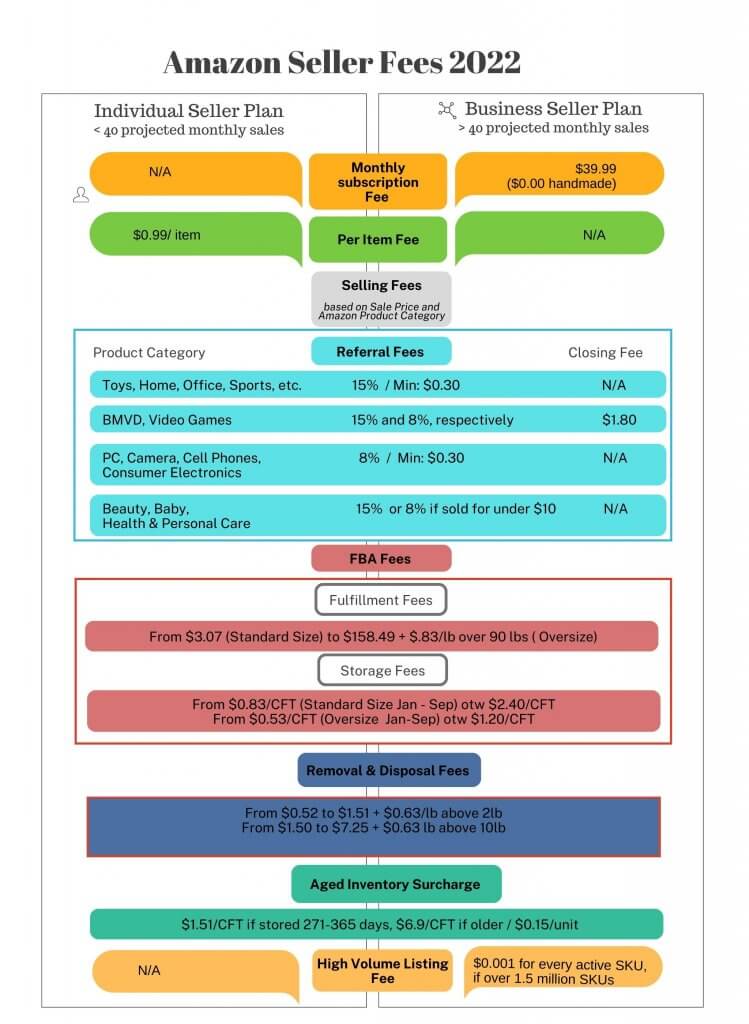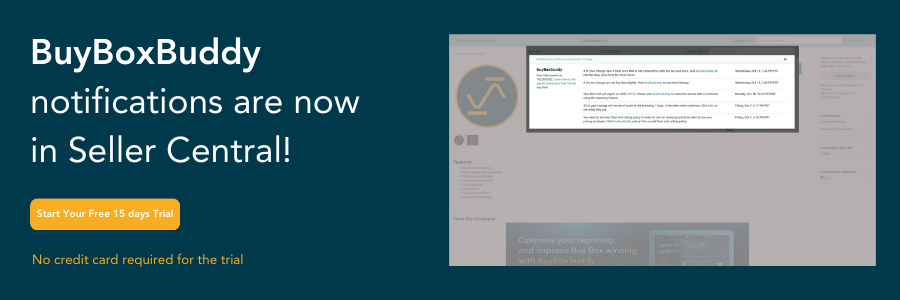
It’s not every day that we get asked about the hidden costs of selling on Amazon. But come to think of it, there are some lesser-known costs and fees that can stop sellers in their tracks. If you’re thinking about becoming a seller and you like to play it safe, here’s how to prepare for hidden cost on Amazon.
Table of Contents
There are many ways to go about selling on Amazon.
For instance, sellers can strike out on their own or hand over their pricing and shipping tasks by signing up to Sold by Amazon (SBA).
There’s also the Customer Service by Amazon (CSBA) offer for self-fulfilled orders.
Whichever of these you opt for, you’ll end up paying a great deal of money to Amazon and its partners every month.
Before you even start to think about the hidden costs of selling on Amazon, you must prepare for the obvious ones, including:
- Monthly subscription.
- Selling on Amazon fees (referral and closing fees).
- FBA fees (fulfillment and monthly storage fees).
- High-volume listing fees.

The figure you get when you use the Amazon FBA Revenue Calculator will give you an idea of the most obvious costs. But there are many fees Amazon doesn’t even mention on the Selling on Amazon page. For instance, all of this comes straight out of your pocket:
- Shipping costs (USPS and courier rates).
- Miscellaneous fees (removal fees, overage fees, and the aged inventory surcharge).
- Brand owner fees for the Inventory Placement Service for items shipped to FBA warehouses, which amounts to $0.3/unit for items over 1lb. or $0.4/unit otherwise.
- Coupon redemption fees of $0.6 per redemption.
- Self-paid tax, Amazon’s Tax collection service, and/or VAT Services on Amazon.
While we’ve gone over all of these Amazon selling fees and the latest FBA fee changes in great detail, we skipped through the hidden costs of selling on Amazon.
Some only apply to newcomers, but most are universal.
Here’s what your hidden cost on Amazon will amount to:
Setting Up Your Bank Accounts
As a US resident selling on Amazon.com, you only need a domestic bank account to get started.
As a foreigner selling on an Amazon venue, you’ll need two accounts.
Let’s take the case of a European seller trying to trade on Amazon.com.
They’ll need:
- A bank account set up abroad (in EUR/USD) to pay Amazon, connected to a Paypal address if they want to pay their suppliers via Paypal until they build trust
- A bank account set up in the USA or a Payoneer account for Amazon to pay them.
Obviously, carrying out transactions through Paypal isn’t cheap.
And waiting for a Payoneer card to start selling can cost you. But in time, you’ll be able to forget about transfer fees and currency conversions as more of your business is carried out with Payoneer.
Another option is to use the Amazon Currency Convertor service.
This enables them to receive payments from Amazon in countries and currencies supported by Amazon.
Fees are based on net proceeds across a year and they range from 0.4% to 1.5%, with a discount for linked accounts.
Finally, there’s the option to open a Hyperwallet account in any of the 25 supported countries and currencies.
There are several fees to pay, including a $2.95 service fee and transfer fees ranging from $0.95 to $8, depending on the type of account or card receiving disbursements.
Setting Up a Legal Entity
Whether you set up a company locally or abroad, it’s very likely that you’ll enlist the help of an accountant who caters exclusively to Amazon sellers.
These professionals can provide valuable insights on virtually every aspect of the business, from startup applications to distance selling rules.
But their services don’t come cheap.
Getting Your Barcodes
Everything you list on Amazon must have a GTIN barcode. You’ll need a code for every item and every version of it (size, color scheme, cover, etc.).
GS1 barcodes don’t come cheap. Buying 10 barcodes will set you back $250, while 100,000 barcodes cost $10,500.
But then there’s also the annual renewal fee, which is a fifth of this.
Brand owners also have the option to sign up to Project Zero and use Transparency, Amazon’s own serialization program.
The advantage is that you can then delete counterfeit listings yourself using a self-service tool.
Amazon will issue special serial numbers for all your products. The price is 1 to 5 cents per product, but Amazon recently rolled out a free code offer.
Registering Your Brand
With an active registered trademark, you can sign up for Brand Registry as soon as you become eligible to manage and personalize your listings.
But registering your trademark with the USPTO will cost you several hundreds of dollars.
In the meantime, you need to build up a reputation for yourself with special offers and discounts
Advertising on Amazon
As soon as you launch your product, you should start advertising with voucher campaigns and volume discounts.
Sellers currently receive a promotional credit of up to $200 when they sign up to Sponsored Products, Amazon’s PPC campaigns.
But becoming eligible takes time.
Also, PPC campaigns can be costly.
Think of a product with a 10% conversion rate (1 in 10 clicks ends with a purchase). You can afford to spend a quarter of its price to sell it (ACoS = 25%). So, a click shouldn’t cost you more than 2.5% of its price. That’s the 2.5 rule.
If what you’re selling on Amazon is a service, then you can advertise with the Amazon Moments (CPA) program.
It involves giving Amazon the liberty to give your users an incentive from the money you pay them.
Prices start at $3 and there’s a monthly budget limit of $5,000 per campaignSellers and vendors have a variety of ad… More and $15,000 per account.
Dealing with Customs
Suppose your supplier in China delivers your products straight to Amazon in the USA. And you live nowhere near these two countries.
If your cargo isn’t hazardous or worth more than $2,500, you have nothing to worry about.
But if it is, you need a customs broker, who charges a percentage of the value of the goods.
Warehousing Costs
You may not have the space to store all your products, or the urge to hand them over to an FBA fulfillment center.
Outsourced warehousing can be flexible, but there are tax implications.
A good accountant may come in handy here too.
Repricer Subscription
Everyone selling on Amazon these days uses a repricer.
BuyBoxBuddy, our new algoritmic real-time repricer, comes with a free 2-week trial.
From then on, you have the option to select from one it the 3 pricing tiers described here.
It pays for itself, but not all repricers do.
Account Suspensions
It’s one thing to lose a listing because it didn’t comply with seller guidelines, and an entirely different thing to have your account suspended.
Not only will you miss out on all those sales, but Amazon may withhold your funds while you’re trying to sort out the issue.
Tackling suspensions is hard and time-consuming. Sometimes you may need the help of professional appeal services.
Our Account Rescue prices are listed openly, but not all appeal service providers are as forthcoming. Check out our rates on the page.
Personal Time
Attending trade shows, expanding your business abroad, and keeping abreast of changes in the world of Amazon sellers takes time.
But there are solutions out there for everything.
You can streamline your product sourcing with Profit Bandit, hand over your pricing initiatives to BuyBoxBuddy, our set-and-forget repricer, or let our Business Coaching team give you some pointers.
Be sure to factor in all these hidden costs of selling on Amazon next time you estimate your margins. And leave room for logistics issues and unreliable suppliers. When all is said and done, hidden cost on Amazon is a small price to pay for getting your product out there.

Melanie takes an active interest in all things Amazon. She keeps an eye on the latest developments and keeps Amazon sellers up to speed.







3 Responses
Iam so glad I have seen this page its put me of trying to open an amazon business all these hidden costs thank you.
kindly inform me from start to end.
i have products but how i take barcodes. i dont have barcodes so what are the procedure to sell these products
Hello,
You can buy barcodes here. https://www.gs1.org/standards/get-barcodes They are spendy, but it’s worth spending the extra money in order to ensure that you get a unique barcode for your item. Let us know if there’s anything else we can help with!